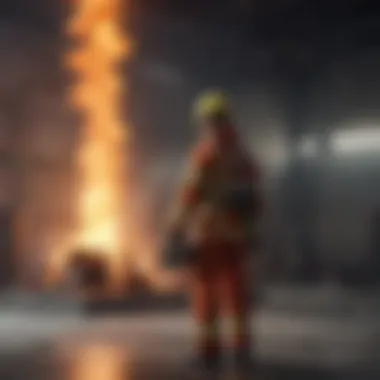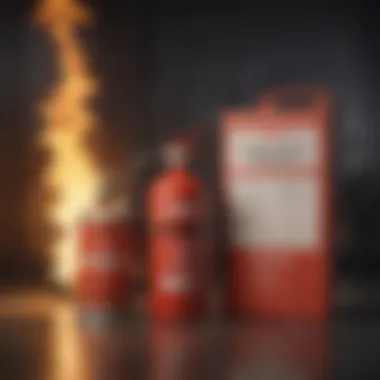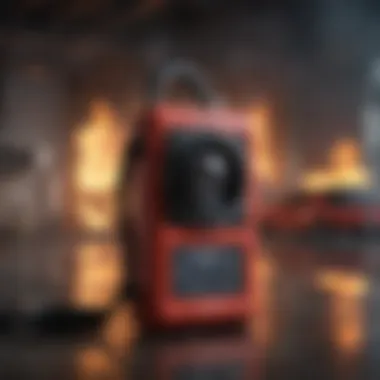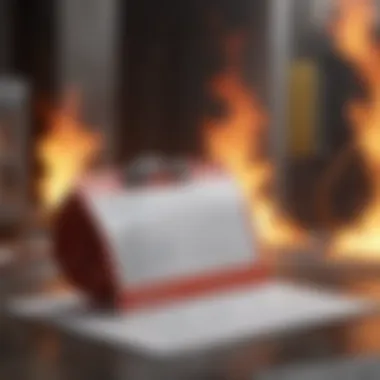Understanding Fire Safety Inspection Companies


Intro
Fire safety is often the unsung hero in the intricate realm of property management and public safety. Whether it’s a small home, a bustling restaurant, or a sprawling manufacturing plant, fire safety inspection companies play a pivotal role in safeguarding lives and assets. They are the gatekeepers, ensuring compliance with safety regulations that can sometimes feel like a tangled web of legal jargon and codes.
Facing the daunting task of keeping a business or home safe can be overwhelming, especially when the threat of fire lurks silently. This is where fire safety inspection companies step in, providing essential services that not only avert disaster but also offer peace of mind. By understanding their function, services, and impact on various industries, stakeholders can make informed decisions that enhance their safety protocols.
In the sections that follow, we’ll explore the coverage options that fire safety inspection firms typically offer, delve into key considerations when selecting a provider, and highlight the qualifications needed to excel in this vital field. With technology changing the game, it's crucial to address how these advancements influence inspections and compliance. Moreover, we will examine the challenges these inspection companies face and present a toolkit for evaluating their reliability. So, let’s roll up our sleeves and get right into it.
Intro to Fire Safety Inspections
In a world where safety cannot be taken lightly, fire safety inspections stand as the first line of defense in preventing catastrophic events. The essence of these inspections cannot be overstated; they weave together policies, practices, and technology that ultimately safeguard lives and property. Fire incidents are not just statistics; they wreak havoc on families, disrupt communities, and have lasting economic impacts. Every year, countless businesses find themselves scrambling to recover from the fallout of a fire, which could have been minimized or completely avoided with thorough inspections.
Having a comprehensive understanding of fire safety inspections is vital for various stakeholders—from homeowners to small business owners—because it fosters awareness of potential hazards and the necessary mitigations. This article provides a detailed look at the importance and intricacies of fire safety inspections, elucidating how they ensure compliance with safety regulations and industry standards.
The Importance of Fire Safety
Fire safety is not merely a box to check off; it's about creating a culture of awareness and readiness. It engenders a mindset where safety measures are prioritized over convenience.
The crucial elements of fire safety include:
- Early Detection: Most modern fire safety systems, such as smoke detectors and alarm systems, are only effective when regularly inspected and maintained. Failures in these systems can lead to disastrous results.
- Risk Assessment: Employees or homeowners who understand their environments can identify potential fire hazards, whether it's flammable materials left in inappropriate places or electrical wires that may pose a risk.
- Emergency Preparedness: Knowing how an inspection process works can also prepare individuals for emergencies, ensuring they know the plan and how to act when it counts.
As we delve into this topic, it’s important to remember that regular fire safety inspections are not just a legal requirement but a pivotal part of responsible management of any property. These actions can save lives and ensure business continuity when the worst-case scenario becomes reality.
Regulatory Framework Surrounding Fire Safety
Navigating the regulatory landscape surrounding fire safety can be perplexing. However, understanding these frameworks is critical. They serve as the foundation for maintaining safety standards and ensuring compliance.
Fire safety regulations vary significantly from one area to another, but common elements include:
- Building Codes: Local and state authorities often have specific codes that buildings must adhere to, dictating the necessary fire protection measures such as fire exits, alarm systems, and sprinkler requirements.
- Inspection Frequency: Regulations often dictate how frequently different types of properties need to undergo inspections. For instance, commercial properties may require more frequent checks compared to residential spaces.
- Penalties for Non-Compliance: Failing to comply with fire safety regulations is more than just a slap on the wrist; it can lead to substantial fines or even the closure of a business.
"Compliance is not an act, but a habit."
Understanding the regulatory framework helps property owners stay abreast of necessary precautions and actions to mitigate risk. Ensuring that fire safety inspections comply with local and national standards not only offers peace of mind but also fosters trust among clients, employees, and visitors.
By actively participating in fire safety practices and keeping informed on regulations, stakeholders significantly reduce their risks, contributing to a safer community overall.
Role of Fire Safety Inspection Companies
Fire safety inspection companies play a crucial role in maintaining safety standards across various settings. Their work doesn't merely tick a box for regulatory compliance; it actively protects lives and property. By ensuring that fire safety measures are in place and functioning correctly, these companies help mitigate risks and reduce potential damages caused by fire incidents. They act as the first line of defense, identifying hazards long before they can escalate into catastrophic events.
Overview of Services Provided
Fire safety inspection companies offer a range of services designed to evaluate and enhance fire safety protocols in different environments. These might include on-site assessments, fire alarm system checks, installation inspections, and consultations to educate property owners about necessary precautions. Each service contributes to a more comprehensive fire safety strategy, ensuring facilities meet local codes and regulations.
The primary aim of these services is not just compliance but also to foster a culture of safety. Clients receive valuable insights on how to improve their fire prevention tactics, which can save lives and resources. A proficient company will tailor their program to meet the specific needs of the client, whether for a bustling commercial space or a quiet residential community.
Types of Fire Safety Inspections
Inspections come in various forms, each serving a distinct purpose to maintain fire safety standards.
Routine Inspections
Routine inspections are carried out regularly—often as mandated by local regulations. These inspections focus on key systems like fire alarms, sprinkler systems, and emergency lighting to ensure they're fully operational. The characterizing feature of routine inspections is their frequency, which can vary from monthly to annually depending on fire codes and company policies.
For property owners, these inspections are beneficial because they catch minor issues before they snowball into major complications. Not only does it help in maintaining equipment, but it also fosters a proactive mindset about fire safety. However, they may not provide a complete picture of a building's fire safety compliance since they often only assess specific elements rather than the whole system.
Comprehensive Inspections


Comprehensive inspections delve deeper into a property's overall fire safety strategy. They assess not only the operational status of fire protection systems but also the layout of escape routes, the storage of flammable materials, and adherence to fire safety plans. A key characteristic of comprehensive inspections is their all-encompassing nature, covering various aspects of fire safety in a single visit.
This is often regarded as a beneficial choice for businesses looking to ensure complete compliance and safety. The unique feature of comprehensive inspections is their ability to reveal weaknesses that might not be detected during routine checks. However, they can be time-consuming and may require more planning and coordination, which some property owners might find challenging.
Post-Incident Inspections
Post-incident inspections are critical after a fire-related event occurs, whether minor or significant. Their purpose is to determine the cause of the incident, evaluate the response measures taken, and recommend improvements for the future. Post-incident inspections are unique because they investigate the actual conditions and responses that occurred during a fire event.
For those affected, such inspections are vital for understanding what went wrong and how to prevent another occurrence. It's not just about pinpointing faults but also about gathering lessons that can inform better practices moving forward. The downside, however, is that they typically come after an unfortunate incident, highlighting a reactive rather than a proactive approach to fire safety.
In summation, fire safety inspection companies provide indispensable oversight through various inspection types. Each type serves its own purpose, contributing to an overarching commitment to safety. By understanding these services, property owners can make informed decisions that protect their assets and, most importantly, the lives within those spaces.
Industries Benefiting from Fire Safety Inspections
Fire safety inspections are crucial across various industries, ensuring compliance with regulations and protecting lives and property. Every sector has its own set of challenges and needs when it comes to fire safety, which is why understanding how different industries benefit from these inspections is essential for business owners and homeowners alike.
Commercial Enterprises
In the world of commercial enterprises, fire safety is non-negotiable. Retail stores, office buildings, and restaurants need to comply with strict fire codes to operate legally and safely. Regular inspections help identify hazards like blocked exits, improper storage of flammable materials, and faulty fire alarms.
- Protecting Assets: A fire can lead to devastating financial losses. Inspections ensure that businesses are taking the necessary steps to prevent such events.
- Customer Safety: Customers should feel safe while visiting; fire safety inspections demonstrate a commitment to their well-being.
- Insurance Compliance: Many insurance policies require proof of regular fire safety inspections. Failing to meet this requirement can lead to higher premiums or even denial of claims.
Industrial Facilities
Industrial facilities pose unique fire risks due to the presence of heavy machinery, chemicals, and combustible materials. Fire safety inspections here focus on both preventative measures and emergency preparedness.
- Tailored Safety Protocols: Each industrial space can require different safety measures. Inspections help customize safety plans specific to the operational characteristics of the facility.
- Regulatory Compliance: Industries like manufacturing or energy production often have specific regulations that must be followed; inspections help ensure compliance with local, state, and federal laws.
- Employee Training: Issues found during an inspection can also inform training programs for employees regarding fire prevention and emergency response.
Residential Properties
For homeowners, fire safety inspections can mean the difference between a minor scare and a major tragedy. Understanding the home’s vulnerabilities can help in bolstering safety measures.
- Identifying Risks: From outdated electrical systems to improperly installed heating units, inspections highlight potential risks that may otherwise go unnoticed.
- Peace of Mind: Residents can rest easier knowing their homes have been evaluated by professionals, providing confidence that they are prepared for emergencies.
- Community Impact: Fire safety is not just an individual concern; a fire in one home can spread to others. Ensuring your home is inspected benefits the entire neighborhood.
"Regular fire safety inspections aren't just about compliance; they are about protecting what matters most—people and property."
Qualifications and Expertise of Inspectors
The significance of having well-qualified and experienced inspectors in the realm of fire safety cannot be overstated. These professionals play a formidable role in safeguarding lives and properties from potential fire hazards. Their expertise is crucial not only for identifying risks but also for ensuring compliance with established safety standards and regulations. By delving into the qualifications and expertise of fire safety inspectors, we can better understand the value they bring to the table.
Training and Certification Requirements
In the world of fire safety inspections, the path to becoming a qualified inspector typically involves thorough training and specific certifications. Various organizations offer courses that equip inspectors with the knowledge necessary to perform their duties effectively.
- Certification Programs: Many aspiring inspectors opt for certifications from recognized bodies, such as the National Fire Protection Association (NFPA). Achieving these certifications signifies that an inspector possesses a deep understanding of fire codes, safety practices, and inspection techniques.
- Practical Training: Beyond textbooks, practical training sessions are pivotal. Even an excellent theoretical grounding won’t cut it without real-world application. Inspectors often engage in hands-on training, which includes site assessments and learning the mechanics of different fire systems. This combination helps inspectors develop critical skills that elevate their service quality.
- Specialized Areas: Depending on the building type—be it commercial or residential—inspectors may pursue specialized training tailored to specific fire safety systems, such as sprinkler systems or alarm systems. Such niche knowledge can make a significant impact during inspections, allowing for more precise evaluations.
Ongoing Education and Standards Compliance
The realm of fire safety is ever-evolving, driven by advancements in technology as well as updates in regulations. This necessitates that inspectors remain committed to ongoing education. Here are some aspects concerning their continual learning process:
- Regular Seminars and Workshops: Many fire inspection professionals attend workshops geared specifically towards the latest updates in codes, technologies, or fire prevention strategies. These opportunities not only reinforce existing knowledge but also introduce inspectors to cutting-edge practices.
- Membership in Professional Organizations: By becoming members of organizations dedicated to fire safety, inspectors can access a wealth of resources, including research papers, case studies, and roundtable discussions. These platforms foster an environment of shared learning where inspectors can benefit from peer experiences.
- Compliance Monitoring: Inspectors also have the responsibility to stay abreast of regulatory changes. Frequent checks into local, state, and national standards are needed to ensure compliance during inspections. Falling behind can result in oversights that could endanger safety—a risk no less than playing with fire.
"Inspectors are the frontline warriors in the battle against fire hazards; their extensive knowledge is not just an asset but a necessity for public safety."
In summary, the qualifications and expertise of fire safety inspectors form the backbone of effective fire prevention measures. Their training and ongoing education translate into a higher standard of inspection, enhancing the safety of buildings and their occupants. Homeowners and business owners alike must recognize the importance of hiring qualified professionals to mitigate risks effectively.
Technology in Fire Safety Inspections
In an age where every aspect of our lives is touched by technology, fire safety inspections are no exception. The integration of advanced tools and data-driven analysis not only enhances the effectiveness of inspections but also ensures a more thorough assessment of fire safety compliance. As fire safety inspection companies adapt to these evolving technologies, they can offer greater value to homeowners, business owners, and property managers alike.
Advancements in Inspection Tools


With the advent of cutting-edge tools, fire safety inspections have transformed dramatically. Gone are the days when inspectors relied solely on traditional methods and checklists. Now, they utilize a host of sophisticated instruments.
- Thermal Imaging Cameras: These tools allow inspectors to evaluate heat patterns in building structures. Identifying hotspots can reveal hidden issues like wiring problems that could lead to fires.
- Digital Gauges: For assessing fire suppression systems like sprinklers or alarms, digital gauges provide real-time data. This immediacy enhances accuracy compared to manual methods, ensuring all functionalities are in check.
- Drone Technology: In hard-to-reach spaces or expansive facilities, drones make inspection safer and more efficient. They can survey rooftops and tall structures with minimal risk, providing valuable visuals that are hard to obtain otherwise.
Benefits of Advancements
Each of these tools contributes not only to a thorough inspection but also streamlines the process. By leveraging technology, fire safety companies can identify potential hazards quickly, ultimately saving time and resources.
Utilization of Data Analytics
In today's data-driven landscape, analytics plays a vital role in fire safety inspections. To fully harness this potential, companies are turning to analytics not just as a tool but as a fundamental component of their inspections.
- Trend Analysis: By analyzing historical data on fire incidents, companies can identify patterns and common hazards that need attention. This proactive approach allows businesses to mitigate risks before they escalate.
- Predictive Modelling: Using statistical models can help predict future incidents based on current data. Fire safety companies can advise clients on high-risk areas, tailoring their strategies accordingly.
- Compliance Tracking: With data analytics, maintaining compliance with local fire codes becomes easier. Companies can automate reminders and track inspections over time, giving clients peace of mind that they are always meeting standards.
"The marriage of technology and fire safety not only ensures compliance but can also prevent disasters before they happen, saving lives and resources."
The End
The role of technology in fire safety inspections cannot be overstated. From improved inspection tools to the clever use of data analytics, the integration of these advancements shapes a more effective and efficient approach. This not only helps in identifying and mitigating hazards but also enables property owners to stay compliant with evolving regulations.
Challenges Faced by Fire Safety Inspection Companies
Understanding the hurdles that fire safety inspection companies encounter is crucial, not only for those in the industry but also for property owners and stakeholders who rely on these inspections for safety. The complexity of fire safety regulations, diverse client needs, and economic factors can create a challenging landscape for inspection firms. Recognizing these challenges can lead to improved practices, better compliance, and overall enhanced safety measures.
Navigating Regulatory Changes
With fire safety regulations being anything but static, companies need to remain vigilant in understanding and adapting to changes. Regulatory bodies continuously revise codes and standards in response to incidents, new research, or technological advancements. For instance, a new regulation might mandate stricter requirements for smoke detectors in certain types of buildings. Failure to stay on top of these changes can result in non-compliance, fines, or worse, catastrophic fire incidents.
- Regularly updating training programs for inspectors can help ensure that everyone is aware of the latest changes.
- Furthermore, subscribing to industry newsletters or joining professional organizations can keep companies informed.
- Engage with local fire marshals and regulatory bodies to foster relationships that support communication and guidance on upcoming changes.
"In each fire safety inspection, it is not just about compliance; it is about accountability to protect lives and property."
Dealing with Inspection Backlogs
Another pressing issue that fire safety inspection companies face is the backlog of inspections. This often arises due to high demand for services, a limited number of qualified inspectors, or inefficiencies in scheduling. When an inspection backlog occurs, it can delay important safety evaluations, leaving properties vulnerable to hazards.
To combat this, companies can implement several strategies:
- Optimize Scheduling: Using software aimed at managing appointments can streamline operations and make more efficient use of inspectors’ time.
- Expand Workforce: Hiring additional qualified inspectors may require an upfront financial investment but can alleviate backlogs and improve service delivery.
- Prioritize Critical Inspections: By focusing on properties with higher risks or compliance concerns, companies can manage their resources better.
As homeowners and business operators, understanding these challenges equips you to engage more effectively with fire safety companies and advocate for necessary resources to ensure timely and comprehensive inspections. Managing the needs for effective inspections is not just a task for inspection firms but a collaborative effort involving both service providers and property users.
Preparing for a Fire Safety Inspection
Preparing for a fire safety inspection is an essential step toward maintaining the safety and compliance of your property. When done properly, it ensures that potential hazards are identified and corrected before any serious issues arise. Remember, fire safety isn't just good practice, it's often required by law. It’s a peek into the state of your fire protection measures and can save lives, property, and ultimately, money.
Steps for Property Owners
Getting ready for a fire safety inspection can seem daunting, but let’s break it down into manageable steps:
- Understand the Requirements: Start by familiarizing yourself with local fire safety codes and regulations. These can vary significantly from one jurisdiction to another. Knowledge is power!
- Conduct a Pre-Inspection: Before the official inspection, walk through your property and identify possible fire hazards. Look for blocked exits, malfunctioning smoke alarms, or improperly stored flammable materials. This self-assessment is crucial.
- Keep Documentation Handy: Ensure you have necessary documents ready. This might include previous inspection reports, plans for fire safety systems, and records of any maintenance work done. Having everything organized shows the inspector that you take safety seriously.
- Notify Staff or Residents: If applicable, inform everyone about the upcoming inspection. This could be employees in a business or residents in a multi-family home. Transparency helps prepare everyone and fosters a culture of safety.
- Schedule the Inspection: Choose a time that minimizes disruption. Ensure that all areas of the property are accessible for inspection. Direct communication with the inspection company can make this process smoother.
By following these steps, property owners can significantly enhance their preparedness, leading to more effective inspections.
Common Areas of Focus During Inspections
During a fire safety inspection, inspectors will usually focus on various key areas that play a critical role in the overall safety of the building. Here are some common focal points:
- Exit Routes: Inspectors check for proper signage and that exits are unobstructed. Clear pathways can be lifesavers in emergencies.
- Fire Extinguishers: They check for adequate coverage, accessibility, and that all extinguishers are certified and up to date.
- Smoke Alarms and Detectors: Functioning smoke systems are vital. Inspectors will test these devices to ensure they are operational.
- Sprinkler Systems: If your property relies on sprinklers, ensure that they are well-maintained, free of obstructions, and that flow tests are conducted regularly.
- Electrical Systems: Watch for any frayed wiring, overloaded outlets, or other electrical hazards. This is an area that can easily be overlooked but can have serious consequences.
- Flammable Materials: Inspectors look for proper storage of hazardous substances. Keeping these materials in designated areas is crucial for reducing risks.
"Regular fire safety inspections not only enhance compliance but can also reveal invisible hazards to save properties and lives."


Being aware of these areas enables property owners to proactively address issues before the inspector arrives, making for a smoother and more efficient inspection process.
Best Practices for Selecting Fire Safety Inspection Companies
Selecting the right fire safety inspection company isn’t just about checking a box; it’s about ensuring the safety of people and property. A solid choice can mitigate risks, save you from potential liabilities, and ensure compliance with regulations. In this section, we’ll dive into crucial elements that highlight how to make an informed selection.
Evaluating Company Credentials
When searching for a fire safety inspection company, the first thing to look into is their credentials. It’s not enough for a company to claim they’re qualified. Here are some essential factors to consider:
- Licensing and Certification: Ensure the company holds valid licenses and certifications recognized in your jurisdiction. This typically includes certifications from organizations like the National Fire Protection Association.
- Experience: Longevity in the business is often a good sign. Companies with years of experience tend to have a deeper understanding of various inspection protocols and challenges. Ask how long they’ve been operating and if they have specialized experience with your type of property.
- Insurance Coverage: A reputable company should have liability insurance. This coverage protects both the company and the property owner in case of accidents during an inspection.
- Professional Associations: Membership in industry associations can indicate a commitment to staying updated on the latest codes and practices. Companies affiliated with such groups often maintain higher standards and best practices.
Reading Customer Reviews and Testimonials
Understanding past client experiences can offer invaluable insight when selecting a fire safety inspection company. Here’s how to approach this:
- Online Reviews: Platforms like Google, Yelp, and Angie's List are treasure troves of consumer feedback. Look for recurring themes in reviews. Are customers generally satisfied? Do they mention punctuality and thoroughness?
- Case Studies: Some companies may provide detailed case studies showcasing how they handled specific challenges. This can give you a more profound understanding of their problem-solving abilities.
- Word-of-Mouth Recommendations: Never underestimate the power of personal recommendations. Ask friends, family, or colleagues if they have had a positive experience with any local inspection companies.
"The best way to judge a service is by the customers who have used it. Trust but verify, as they say!"
Ultimately, investing time in researching and selecting the right fire safety inspection company can pay dividends. Not only can it ensure compliance with safety standards, but it can also safeguard lives and property. As the saying goes, an ounce of prevention is worth a pound of cure.
The Future of Fire Safety Inspections
In the realm of fire safety inspections, change is a constant companion. As technological advancements continue to reshape various industries, fire safety inspection companies are on the brink of significant transformations. Understanding what lies ahead is not merely advisable; it's essential. This section explores emerging trends and the role of artificial intelligence and machine learning, which promise to revolutionize how inspections are conducted.
Emerging Trends in Fire Safety
The fire safety landscape is evolving at a brisk pace, reflecting broader societal shifts and technological innovations. Here are some notable trends shaping the future of fire safety inspections:
- Increased Use of Drones: Drones are finding their way into fire safety inspections, offering a bird's-eye view of hard-to-reach areas. They provide high-resolution imagery and help inspectors gather data without risking personal safety. This technology is especially useful in large commercial properties and industrial sites.
- Smart Building Technologies: The integration of smart technologies into buildings is becoming common. These systems can monitor fire risks in real time. Sensors detect smoke, temperature changes, and gas leaks, alerting building occupants and emergency services automatically. As these technologies grow more sophisticated, they will likely influence inspection protocols.
- Regulatory Changes: Fire safety regulations are always in flux. Companies must stay attuned to new rules, which often arise in response to major incidents. Being proactive in implementing changes ensures both compliance and safety. An example is the new codes that may evolve from lessons learned during high-profile fire disasters.
- Enhanced Training Programs: As new technologies emerge, the demand for well-trained inspectors rises. Companies will likely invest in ongoing education to ensure their workforce is equipped with the latest knowledge and skills. This could mean accredited online courses and specialized workshops focusing on the newest inspection technologies or safety regulations.
Incorporating these trends will not just benefit fire safety inspection firms but also their clients—property owners, businesses, and organizations—by reinforcing safety measures and reducing risks.
The Role of AI and Machine Learning
Artificial intelligence and machine learning are paving the way for a more efficient and thorough approach to fire safety inspections. By automating mundane tasks and analyzing vast amounts of data, these technologies can significantly enhance inspection practices. Some key players in this transformation include:
- Predictive Analytics: AI systems can analyze historical data to predict potential fire hazards before they escalate into serious issues. For instance, if certain types of failures tend to occur in specific environments, predictive analytics can proactively address these concerns, potentially preventing disasters.
- Automation of Reporting: AI can streamline the reporting process. This means that rather than inspectors spending hours drafting reports after an inspection, AI tools can generate them automatically based on the data collected during inspections. This reduces human error and allows for tailored reports specific to each property.
- Enhanced Image Analysis: Machine learning can analyze images captured during inspections more accurately and quickly than human inspectors. This capability means that flaws or areas of concern that might be missed during an inspection could now be identified and addressed promptly, improving overall safety.
"The future of fire safety inspections is not just about compliance; it’s about creating safer environments through technology and data-driven decisions."
- Integration with Emergency Response: AI can facilitate better communication with emergency services during an incident, relaying crucial data regarding building layout and potential hazards, which is invaluable for first responders.
In summary, the future of fire safety inspections is set for breathtaking advancements. By staying abreast of these trends and leveraging technology, companies can enhance safety, compliance, and overall effectiveness. The ongoing evolution toward smarter, data-driven inspections not only helps fulfill legal requirements but also upholds a higher standard of safety for all.
Ending
Fire safety inspections play a pivotal role in establishing and maintaining safe environments for both residential and commercial properties. This article has explored numerous aspects related to fire safety inspection companies, emphasizing their crucial importance in ensuring compliance with safety regulations and standards. The discussion highlighted the essential services these firms provide, ranging from routine checks to comprehensive evaluations following incidents, which can significantly mitigate risks associated with fire hazards.
Recap of Key Points
As we draw this analysis to a close, let’s revisit some key takeaways:
- Importance of Inspections: Regular fire safety inspections help detect vulnerabilities before they escalate into real threats, providing peace of mind to property owners.
- Qualified Personnel: Fire safety inspectors undergo rigorous training and certification, ensuring they possess the necessary skills and knowledge to carry out effective evaluations.
- Technological Integration: Advancements in tools and data analytics are redefining how inspections are conducted, making them more efficient and thorough.
- Challenges in the Sector: Companies face ongoing challenges, such as adapting to regulatory changes and managing inspection backlogs, which can impact service delivery.
The essence of these points reveals that not only is fire safety an obligation mandated by law, it is also a critical practice integral to protecting lives and properties.
Call to Action for Property Owners
For homeowners and business operators alike, engaging with fire safety inspection companies is not just a legal requirement but a vital aspect of risk management. Consider the following actions:
- Schedule Regular Inspections: Don’t wait for the deadlines; initiate regular fire safety inspections to understand your property’s current safety standing.
- Stay Informed: Familiarize yourself with local fire safety regulations. Knowledge is power; understanding what is required can help in preventing costly fines or, worse, unsafe situations.
- Invest in Training: Provide fire safety training for staff or family members. Being knowledgeable about safety protocols is essential in emergencies.
- Review Inspector Credentials: When hiring an inspection company, thoroughly evaluate their certifications and reputation.
"An ounce of prevention is worth a pound of cure." Don't take fire safety lightly – act proactively to safeguard your environment.
By embracing fire safety inspections, you’re not only taking responsibility but also contributing to the broader commitment of promoting safety within your community. Fire safety is a shared responsibility; let’s work together to make it a priority.



